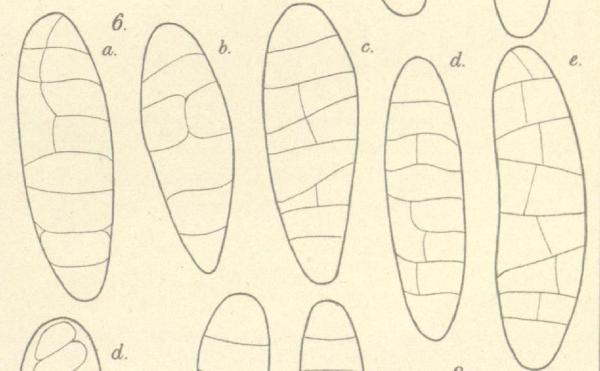Polyblastia maculata Zschacke
Magy. Bot. Lapok, 11: 301, 1912.
Synonyms:
Distribution:
Description: Thallus crustose, endosubstratic, continuous, grey green, with numerous darker dots. Perithecia black, globose, 0.4-0.6 mm across, completely immersed and leaving pits in the rock, macroscopically appearing as small olive-black dots. Involucrellum absent or fully merged with the exciple; exciple dark throughout, thicker in the region around the ostiole; hamathecium of periphyses and periphysoids, interascal filaments absent; hymenial gel hemiamyloid, I+ red (I+ blue at very low concentrations of I), K/I+ blue. Asci 8-spored, clavate, K/I–, fissitunicate, the wall thickened above, with an ocular chamber, dehiscent by extrusion of an endotunica to form a delicate rostrum. Ascospores at first 3-septate, then submuriform with 4-7 transverse septa and 1(-2) longitudinal septa, hyaline, elongate-ellipsoid, (50-)52-68 x 14-18(-21). Photobiont chlorococcoid. Spot tests: K-, C-, KC-, P-, UV-. Chemistry: without lichen substances.Note: a poorly known species of hard calcareous rocks above treeline, resembling P. clandestina in the endolithic thallus and the ascomata immersed in pits, but with larger, narrow ascospores with 5-7 transverse septa and a single, incomplete longitudinal septum; on limestone in Eastern and Central Europe, with a single record from the Eastern Alps (Austria). To be looked for in the Italian Alps.
Growth form: Crustose
Substrata: rocks
Photobiont: green algae other than Trentepohlia
Reproductive strategy: mainly sexual
Poorly known taxon in need of further study

Predictive model
Growth form: Crustose
Substrata: rocks
Photobiont: green algae other than Trentepohlia
Reproductive strategy: mainly sexual
Poorly known taxon in need of further study

Predictive model


